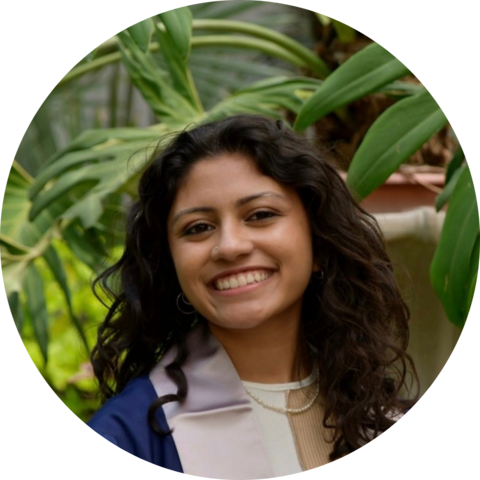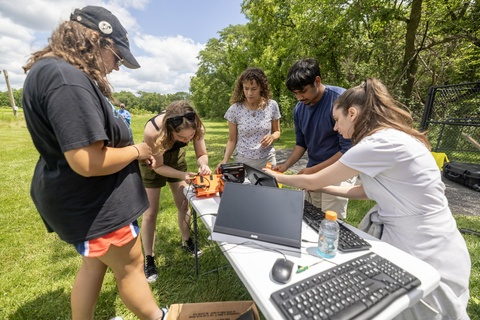
Breadcrumb
Uniting bright minds and innovative technologies
Fourteen students from across the country participated in the 2024 Edge of Space Academy, a two-week experience that combines technical training with hands-on experience. It is led by experts from Iowa’s physics and astronomy and geographical and sustainability sciences departments.
This year's academy featured projects to measure cosmic rays, plant height, and plant spectra. Student teams built instruments and collected data to analyze and present.

One project involved a high-altitude balloon equipped with Geiger tubes to measure cosmic rays as a function of altitude. Arissa Khan, who is double majoring in physics and chemistry at the University of Iowa, learned to solder, program Arduinos and Raspberry Pis, and design circuit boards. The academy is designed for students who don’t have much experience in hardware, instrumentation, or electronics.
“It was a lot of like trial and error for all of us,” Khan says. “But it was really, really cool.”
The balloon, launched in collaboration with Iowa State University, provided valuable data on cosmic radiation, showcasing the students' ability to handle complex instrumentation and data collection.
Other projects focused on measuring biodiversity in a restored prairie using drone-based technologies. One involved building a LiDAR (Light Detection and Ranging) system to measure plant height. The other involved building a handheld spectrometer to analyze electromagnetic radiation reflected from plants.
“One team took the approach of measuring plant height to quantify biodiversity in different ages of restored prairie,” says Susan Meerdink, assistance professor in geographical and sustainability science. “Their hypothesis was that a more established restored prairie would have a larger variability in plant heights because there would be more species that differ in height. Their instrument successfully captured differences in height variation between the restored prairies.”
Meerdink teaches the academy alongside Allison Jaynes, associate professor and director of graduate studies in the Department of Physics and Astronomy, and Adam Skibbe, senior GIS administrator and adjunct instructor in the Department of Geographical and Sustainability Sciences. Each brings a unique perspective and expertise to the program, ensuring a comprehensive learning experience for students.
“We tag team to create the complete experience,” Skibbe says. “We're all trying to make sure the students are successful."
Jaynes says the short, focused experience of the academy opens it up to participants who may not otherwise be able to participate.
“A lot of students need to work or have other obligations during the summer and can’t spend three months at a research institute,” Jaynes says. “But they can spend two weeks, especially if it’s paid.”
Learning from experience
The 2023 high-altitude balloon was not recovered for a year after the flight. To mitigate that risk for the 2024 flight, students improved and augmented the balloon-tracking technology and recovered the balloon within hours of searching Iowa cornfields.
“We have complicated wind-forecasting software that can look at where we think that exact landing position will be, and a beacon from the balloon that helps tell us where it is,” Jaynes says. “When it gets too close to the ground, we lose the signal. From there, it’s a bit of a search-and-rescue mission to find the balloon payload. Luck is also a part of it!”
Calibrating and testing instruments and problem-solving are key aspects of learning.
“It's one thing to build it and get the Arduino code up and running, but the most critical part for technology is making sure it is collecting the desired data at the accuracy you need,” Meerdink says.
The Edge of Space Academy's emphasis on trial and error, using cost-effective components, allows students to learn from mistakes without fear of failure.

“We gave them cost-affordable parts so they could explore and learn without worrying about damaging expensive equipment,” Meerdink says. “We also expose them to off-the-shelf, typically expensive, versions of the instrumentation they build so they can draw comparisons from what they are learning to the state-of-the-art.”
Building skills and networks
The Edge of Space Academy is designed to equip students with both technical and soft skills. It fosters a strong sense of community, with alumni returning for a video call on the last day of the session to trade stories with the current cohort.
Khan's journey is a testament to the Edge of Space Academy’s impact. Initially unsure of her abilities, she excelled in the program and secured a position in Jaynes's lab, now working on the OCHRE student rocket mission.
“There’s such a sense of pride of what they’ve accomplished at the end,” Meerdink says. “This is just a really heartwarming experience for us. We want to build up this network so the students have people they can ask for advice or mentorship. The previous cohorts are providing this support, and it is wonderful.”